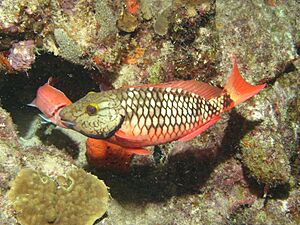Stoplight parrotfish facts for kids
Quick facts for kids Stoplight parrotfish |
|
|---|---|
 |
|
| Male (terminal phase) | |
| Conservation status | |
| Scientific classification | |
| Synonyms | |
|
The stoplight parrotfish (Sparisoma viride) is a colorful fish that lives in the ocean. It's a type of parrotfish found in coral reefs. You can spot them in places like Florida, the Caribbean Sea, the Gulf of Mexico, Bermuda, and even down to Brazil. This fish mostly eats algae by using its strong teeth to scrape it off rocks. Like many parrotfish, it can actually change its sex during its life.
The name "stoplight" comes from a bright yellow spot near its fins. This spot looks a bit like a traffic light and is easiest to see when the fish is in its final life stage.
Contents
Amazing Color Changes: Life Phases
The stoplight parrotfish is special because it can change its sex from female to male as it gets older. This change is often linked to its hormones. As it changes sex, its colors also change a lot!
This fish goes through three main life stages:
- Juvenile: A young fish.
- Initial Phase: At this stage, the fish can be either male or female. They are usually brown with a red belly.
- Terminal Phase: At this stage, the fish is definitely a male. They become a bright, vivid green with yellow spots near their tail.
It's interesting to know that some males might not change color right when they change sex. In the initial phase, a small number of smaller fish are already male.
Where Stoplight Parrotfish Live
Stoplight parrotfish live in shallow coral reefs that aren't too disturbed by people. They are found in places like Florida, the Caribbean Sea, the Gulf of Mexico, Bermuda, and Brazil. These fish are only active during the day. They spend most of their time looking for food, swimming, or just hovering in the water. At night, they hide under coral rocks to stay safe.
Bigger parrotfish tend to swim more and hide in small cracks in the coral. Smaller ones spend more time hovering. You'll find lots of stoplight parrotfish where there's plenty of algae for them to eat. Once they are adults, they usually stay in the same area and don't travel far.
In the Florida Keys, these fish are often found where there's a lot of a type of seaweed called Dictyota. They also like areas with branching corals like Porites porites. Because there are so many stoplight parrotfish in the Caribbean, they are very important for the health of the coral reefs there.
Reef Homes: Onshore vs. Offshore
Stoplight parrotfish living closer to the shore (onshore reefs) tend to be younger. This might mean that older fish either die or move away from these areas more often. Fish on reefs further from the shore (offshore reefs) are generally bigger and live longer. For example, fish onshore might live up to 4 years, while those offshore can live 7 or 8 years. It's possible that older fish move from onshore to offshore reefs, but scientists haven't found clear proof of this yet.
What Stoplight Parrotfish Eat
The stoplight parrotfish is a "grazer." This means it scrapes and digs for its food, which is almost entirely algae growing on dead coral. They eat more and get more energy from food in areas where the algae is of high quality.
They prefer to eat large, thin layers of algae that grow on rocky surfaces, especially those with algae inside the rock. Algae is a great food source for them because it has lots of protein and energy. Sometimes, adult parrotfish will also eat living corals, especially Montastrea annularis. In healthy reefs, the small amount of coral they eat is usually balanced by the good they do by eating algae. However, if a coral reef is already struggling, parrotfish eating coral could make it harder for the reef to grow back. They don't usually like to eat crusty red algae, whether it has other algae growing on it or not.
Their way of finding food is called "search and nip." They spend short bursts of energy swimming, eating, and hovering.
How Stoplight Parrotfish Grow
Stoplight parrotfish keep growing throughout their lives. The more food they have, the faster they grow. The biggest stoplight parrotfish are usually those in their terminal phase.
These fish typically grow to be about 30 to 45 centimeters (1 to 1.5 feet) long. However, some can reach up to 64 centimeters (about 2 feet) in length! During the day, you can usually find them at depths between 4.5 and 24 meters (15 to 80 feet), but they can be found from 3 to 50 meters (10 to 164 feet) deep.
Reproduction and Family Life
Stoplight parrotfish breed all year long. They live in groups where one male in the terminal phase defends an area. This area is shared with 1 to 14 initial phase parrotfish, which are the females he mates with. Males defend their territories more strongly when there's a lot of good food available. Single terminal phase males also protect the deeper parts of the reef from other parrotfish of the same species.
Male stoplight parrotfish often control areas that have many adult females so they can breed. Males who have these territories tend to have very different hormone levels compared to males who don't have territories.
Images for kids





